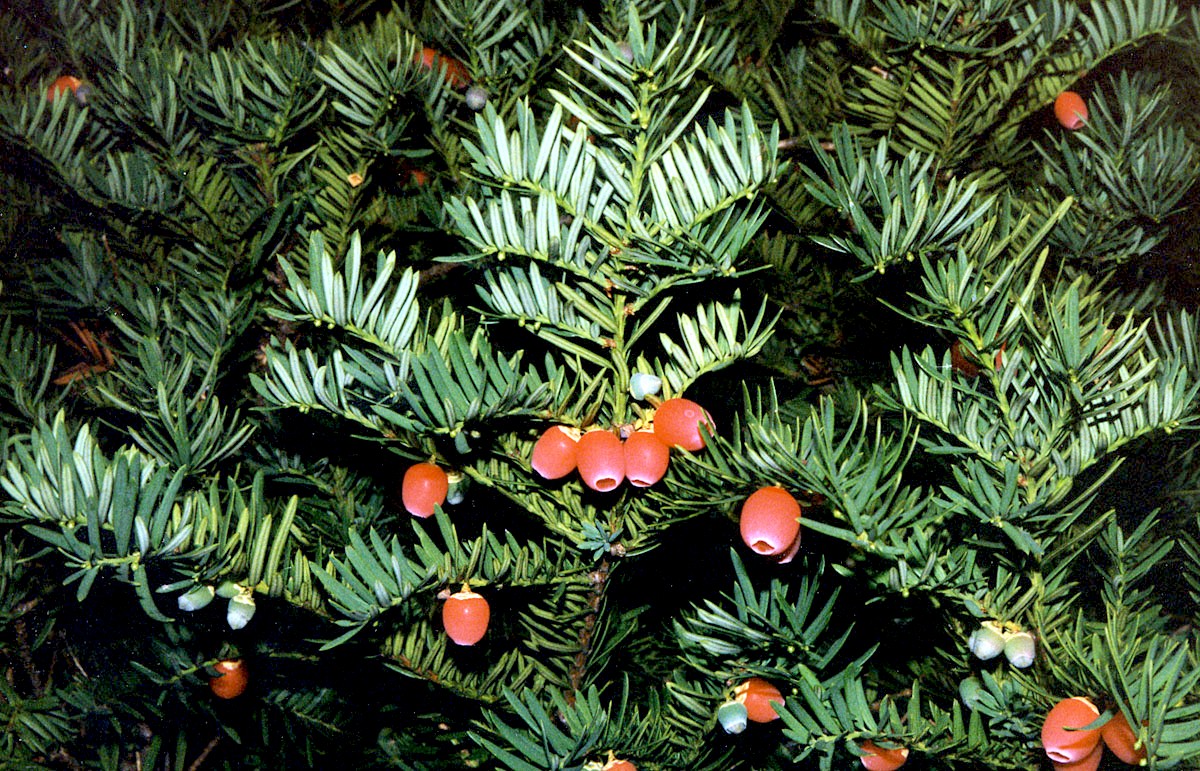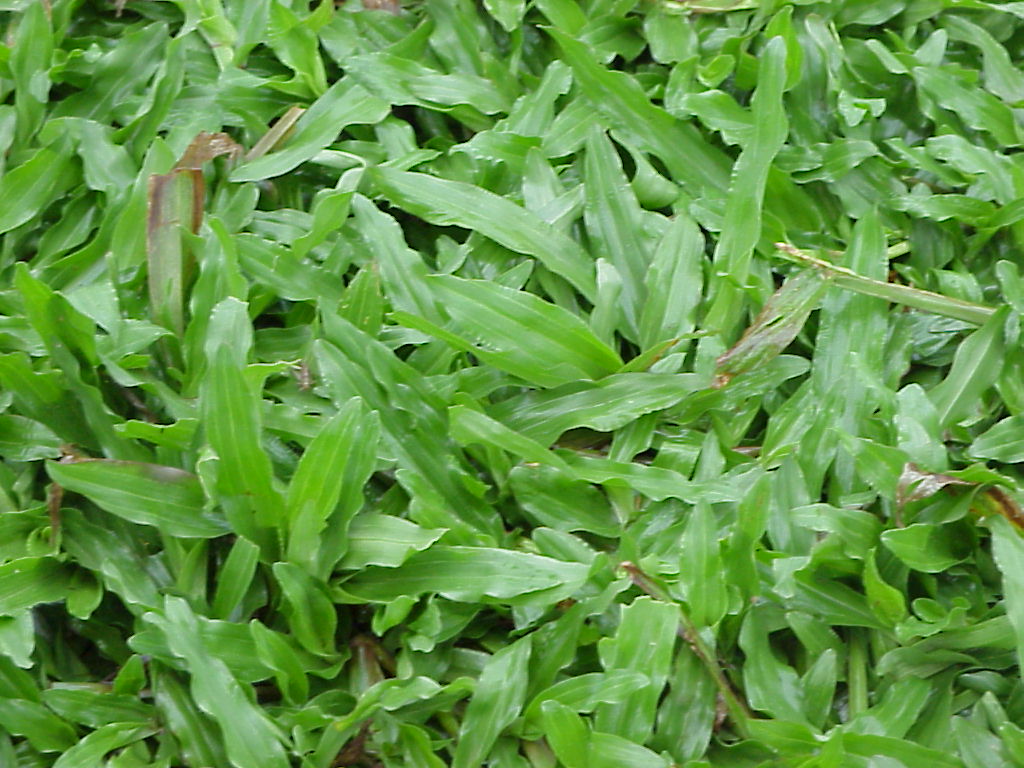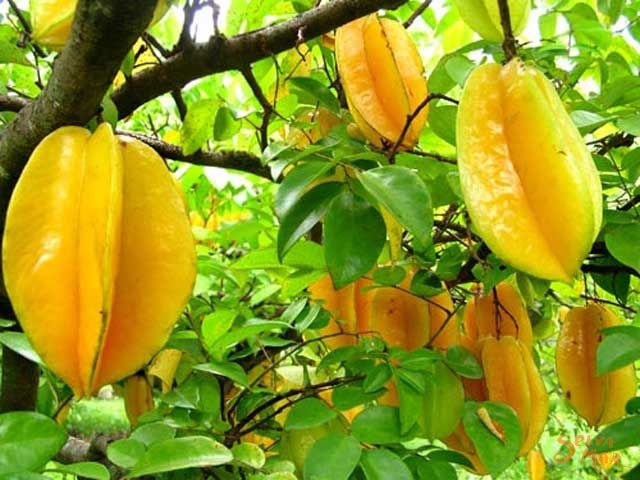 Taxus cuspidata (Japanese Yew or Spreading Yew) is a member of the genus Taxus, native to Japan, Korea, northeast China and the extreme southeast of Russia.
It is an evergreen tree or large shrub growing to 10–18 m tall, with a trunk up to 60 cm diameter. The leaves are lanceolate, flat, dark green, 1–3 cm long and 2–3 mm broad, arranged spirally on the stem, but with the leaf bases twisted to align the leaves in two flattish rows either side of the stem except on erect leading shoots where the spiral arrangement is more obvious.
The seed cones are highly modified, each cone containing a single seed 4–8 mm long partly surrounded by a modified scale which develops into a soft, bright red berry-like structure called an aril, 8–12 mm long and wide and open at the end. The arils are mature 6–9 months after pollination. Individual trees from Sikhote-Alin are known to have been 1,000 years old.
Taxus cuspidata (Japanese Yew or Spreading Yew) is a member of the genus Taxus, native to Japan, Korea, northeast China and the extreme southeast of Russia.
It is an evergreen tree or large shrub growing to 10–18 m tall, with a trunk up to 60 cm diameter. The leaves are lanceolate, flat, dark green, 1–3 cm long and 2–3 mm broad, arranged spirally on the stem, but with the leaf bases twisted to align the leaves in two flattish rows either side of the stem except on erect leading shoots where the spiral arrangement is more obvious.
The seed cones are highly modified, each cone containing a single seed 4–8 mm long partly surrounded by a modified scale which develops into a soft, bright red berry-like structure called an aril, 8–12 mm long and wide and open at the end. The arils are mature 6–9 months after pollination. Individual trees from Sikhote-Alin are known to have been 1,000 years old.
Japanese yew is a broad-columnar needled evergreen tree or multistemmed shrub that is native to Korea, China, Russia and Japan. In its native habitat, it will grow to as much as 30-50’ tall. Cultivated plants will grow much smaller, particularly if regularly pruned. It features linear, spiny-tipped, dark green needles (to 1” long). Leaves are often tinged yellow beneath. Foliage may turn reddish-brown or yellow in winter. Scaly, reddish brown bark.

Although classified as a conifer, female yews (plants are dioecious) do not produce cones, but instead produce red, ornamentally-attractive, berry-like fruits, each having a single seed almost completely surrounded by a fleshy red aril. ‘Capitata’ is very similar to the species except that its form is more pyramidal. Female plants may produce abundant fruit that is attractive to birds. Specific epithet is in reference to the cuspidate (having a sharp pointed tip) foliage.
 The olive tree is the oldest known cultivated tree in history. Olives were first cultivated in Africa, and then spread to Morocco, Algiers, and Tunisia by the Phoenicians. Olea europaea was first cultivated in Crete and Syria over 5000 years ago. Around 600 BC olive tree cultivation spread to Greece, Italy and other Mediterranean countries.
The olive tree played a huge role in the civilization of the Mediterranean countries. Athens was named after the goddess Athena who brought the olive
The olive tree is the oldest known cultivated tree in history. Olives were first cultivated in Africa, and then spread to Morocco, Algiers, and Tunisia by the Phoenicians. Olea europaea was first cultivated in Crete and Syria over 5000 years ago. Around 600 BC olive tree cultivation spread to Greece, Italy and other Mediterranean countries.
The olive tree played a huge role in the civilization of the Mediterranean countries. Athens was named after the goddess Athena who brought the olive
tree to the city. Historically it played a very important role in areas such as religion, diet, and art. It is also known as the symbol for peace, wisdom and victory. In the early Olympic games the winners were crowned with wreaths made of olive branches. Holy people were anointed with olive oil, and Moses exempted men who would grow olives from military service.
It isn't accurately known what the botanical ancestor of the modern olive tree is, but it is believed to be Oleaster olea sylvestris, which still grows wild in North Africa, Portugal, Southern France, Italy and areas around the Black and Caspian Seas. Some think that it originated from a tree which covered much of the Sahara Desert before the glaciers.
The olive tree, Olea europaea, is an evergreen tree or shrub native to the Mediterranean, Asia and Africa. It is short and squat, and rarely exceeds 8–15 m (26–49 ft) in height. However, the Pisciottana, a unique variety comprising 40,000 trees found only in the area around Pisciotta in the Campania region of southern Italy often exceeds this, with correspondingly large trunk diameters. The silvery green leaves are oblong, measuring 4–10 cm (1.6–3.9 in) long and 1–3 cm (0.39–1.18 in) wide. The trunk is typically gnarled and twisted.
The small white, feathery flowers, with ten-cleft calyx and corolla, two stamens and bifid stigma, are borne generally on the previous year's wood, in racemes springing from the axils of the leaves.
The fruit is a small drupe 1–2.5 cm (0.39–0.98 in) long, thinner-fleshed and smaller in wild plants than in orchard cultivars. Olives are harvested in the green to purple stage. Canned black olives may contain chemicals (usually ferrous sulfate) that artificially turn them black. Olea europaea contains a seed commonly referred to in American English as a pit or a rock, and in British English as a stone.
 Agave americana, common names century plant, maguey or American aloe, is a species of flowering plant in the family Agavaceae, originally native to Mexico, Arizona and Texas but cultivated worldwide as an ornamental plant. It has become naturalized in many regions including the West Indies, parts of South America, the Mediterranean Basin, parts of Africa, India, China, Korea, Thailand, New Zealand, Australia and an assortment of oceanic islands.
Although it is called the century plant, it typically lives only 10 to 30 years. It has a spreading about 4 ft (1.2 m) of gray-green leaves up to 2 ft (0.6 m) long, each with a prickly margin and a heavy spike at the tip that can pierce to the bone. When it flowers, the spike has big yellow flowers and may reach up to 8 ft (2.4 m) tall.
Its common name derives from its semelparous nature of flowering only once at the end of its long life. The plant dies after flowering, but produces suckers or adventitious shoots from the base, which continue its growth.
Agave americana, common names century plant, maguey or American aloe, is a species of flowering plant in the family Agavaceae, originally native to Mexico, Arizona and Texas but cultivated worldwide as an ornamental plant. It has become naturalized in many regions including the West Indies, parts of South America, the Mediterranean Basin, parts of Africa, India, China, Korea, Thailand, New Zealand, Australia and an assortment of oceanic islands.
Although it is called the century plant, it typically lives only 10 to 30 years. It has a spreading about 4 ft (1.2 m) of gray-green leaves up to 2 ft (0.6 m) long, each with a prickly margin and a heavy spike at the tip that can pierce to the bone. When it flowers, the spike has big yellow flowers and may reach up to 8 ft (2.4 m) tall.
Its common name derives from its semelparous nature of flowering only once at the end of its long life. The plant dies after flowering, but produces suckers or adventitious shoots from the base, which continue its growth.
 In the tequila-producing regions of Mexico, agaves are called mezcales. The high-alcohol product of agave distillation is called mezcal; Agave americana is one of several agaves used for distillation. A mezcal and tequila, is produced from Agave tequilana, commonly called "blue agave". There are many different types of mezcal some of which may be flavored with the very pungent mezcal worm.
Mezcal and tequila, although also produced from agave plants, are different from pulque in their technique for extracting the sugars from the heart of the plant, and in that they are distilled spirits. In mezcal and tequila production, the sugars are extracted from the piñas (or hearts) by heating them in ovens, rather than by collecting aguamiel from the plant's cut stalk. Thus if one were to distill pulque, it would not be a form of mezcal, but rather a different drink.
Agave nectar, also called agave syrup, is marketed as a natural form of sugar with a low glycemic index that is due to its high fructose content.
In the tequila-producing regions of Mexico, agaves are called mezcales. The high-alcohol product of agave distillation is called mezcal; Agave americana is one of several agaves used for distillation. A mezcal and tequila, is produced from Agave tequilana, commonly called "blue agave". There are many different types of mezcal some of which may be flavored with the very pungent mezcal worm.
Mezcal and tequila, although also produced from agave plants, are different from pulque in their technique for extracting the sugars from the heart of the plant, and in that they are distilled spirits. In mezcal and tequila production, the sugars are extracted from the piñas (or hearts) by heating them in ovens, rather than by collecting aguamiel from the plant's cut stalk. Thus if one were to distill pulque, it would not be a form of mezcal, but rather a different drink.
Agave nectar, also called agave syrup, is marketed as a natural form of sugar with a low glycemic index that is due to its high fructose content.
A member of the grass family, large crabgrass (Digitaria sanguinalis) is purplish or green and has very hairy leaves and sheaths. Leaves are 1/4 to 1/3 inch (6 to 8 mm) wide and 2 to 6 inches (5 to 15 cm) long.
Seedling Description
 The leaf sheaths of large crabgrass seedlings are tinged purple and are covered with long, stiff hairs. The ligule is membranous, flat at the top, and smooth. Auricles are absent. The first leaf is only about twice as long as it is wide. It is tinged light purple and has a white stripe running down the center and a whitish vein at the margin. Both sides have silky, shiny hairs. Leaves taper to a point and have many veins and rough margins. The youngest leaf is rolled in the bud shoot.
The leaf sheaths of large crabgrass seedlings are tinged purple and are covered with long, stiff hairs. The ligule is membranous, flat at the top, and smooth. Auricles are absent. The first leaf is only about twice as long as it is wide. It is tinged light purple and has a white stripe running down the center and a whitish vein at the margin. Both sides have silky, shiny hairs. Leaves taper to a point and have many veins and rough margins. The youngest leaf is rolled in the bud shoot.
Biology
A member of the grass family, large crabgrass is purplish or green and has very hairy leaves and sheaths. Leaves are ¼ to 1/3 inch (6 to 8 mm) wide and 2 to 6 inches (5 to 15 cm) long. In most areas of the country, large crabgrass is an annual, but in some areas it grows like a perennial-rooting at the nodes and forming mats in moist soils. These mats occasionally grow upright.
Large crabgrass reproduces by tillers and seeds, a single plant producing as many as 700 tillers and 150,000 seeds. Plants can produce seeds at mowing heights as low as ¼ inch (6 mm). If top growth is periodically mowed, two to three seed crops may form in a single growing season.
Solanum americanum, commonly known as American nightshade or Glossy nightshade is a herbaceous flowering plant of wide though uncertain native range. The certain native range encompasses the tropics and subtropics of the Americas, Melanesia, New Guinea, and Australia.
 The plant is widely naturalised around the Tropical Pacific and Indian Oceans, including Hawaiʻi, Indochina, Madagascar and Africa, possibly via anthropogenic introduction in these locales.
Solanum americanum is one of the most widespread and morphologically variable species belonging to the section Solanum.It can be confused with other black nightshade species in the Solanum nigrum complex.
The plant is widely naturalised around the Tropical Pacific and Indian Oceans, including Hawaiʻi, Indochina, Madagascar and Africa, possibly via anthropogenic introduction in these locales.
Solanum americanum is one of the most widespread and morphologically variable species belonging to the section Solanum.It can be confused with other black nightshade species in the Solanum nigrum complex.
 Solanum nigrum (soLAYnum KNEEgrum, the Black Nightshade) is found in the Old World, Africa to India and beyond. Its leaves are used as a green, boiled twice or more like pokeweed. In Kenya four varieties of it grow and three are highly sought after. It is the prime potherb. The fourth variety is considered too bitter to eat. Of 61 greens tested in Africa, S. nigrum had the highest amount of vitamin A. In the region of India the plant has many names and is firmly in the human food chain and very popular. It is also in medical use. Modern Greeks call it “Styfno. They boil the leaves then use them as the basis for a salad.
Solanum nigrum (soLAYnum KNEEgrum, the Black Nightshade) is found in the Old World, Africa to India and beyond. Its leaves are used as a green, boiled twice or more like pokeweed. In Kenya four varieties of it grow and three are highly sought after. It is the prime potherb. The fourth variety is considered too bitter to eat. Of 61 greens tested in Africa, S. nigrum had the highest amount of vitamin A. In the region of India the plant has many names and is firmly in the human food chain and very popular. It is also in medical use. Modern Greeks call it “Styfno. They boil the leaves then use them as the basis for a salad.
Actinidia arguta (hardy kiwi) is a perennial vine native to Japan, Korea, Northern China, and Russian Siberia. It produces a small fruit resembling the kiwifruit.
Actinidia arguta, is also known as Hardy kiwifruit, kiwi berry, baby kiwi, grape kiwi, are edible, berry or grape-sized fruit similar to kiwifruit in taste and appearance, but are green, brownish, or purple with smooth skin, sometimes with a red blush. Often sweeter than the kiwifruit, hardy kiwifruit can be eaten whole and need not be peeled. Thin-walled, its exterior is smooth and leathery.typically grown for its attractive foliage and edible fruit. It is native to woodlands, mountain forests, streamsides and moist locations in eastern Asia, China and Japan. It grows to 25-30' or more, but growth is often so rampant that this vine, in its native habitat, may climb to as much as 100' into large trees. Broad-ovate to elliptic deep green leaves (3-5" long) emerge in spring, scented greenish-white flowers (to 3/4" long) bloom in June and edible grape-sized smooth-skinned fruits (to 1 1/4" long) mature in September-October. Species plants are dioecious (separate male and female plants), with at least one male pollinator needed for fruit set on female vines.
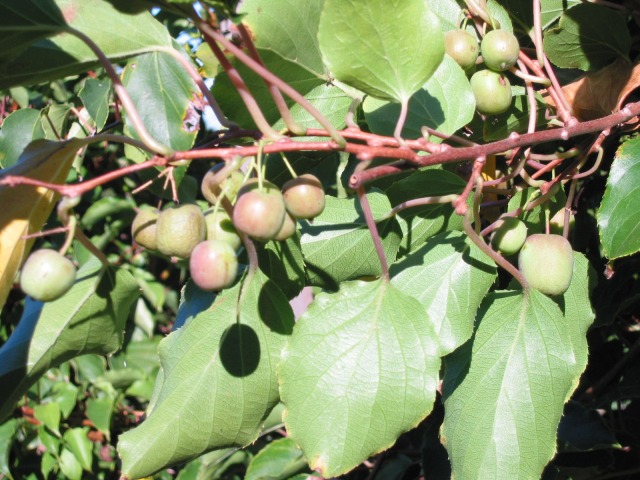 It tastes similar to, though slightly sweeter than, its larger-fruited relative, the true kiwi, Actinidia deliciosa, which can not be grown north of Zone 8.
It tastes similar to, though slightly sweeter than, its larger-fruited relative, the true kiwi, Actinidia deliciosa, which can not be grown north of Zone 8.
Axonopus compressus, also known as carpet grass is a species of grass in the genus Axonopus. It is often used as a permanent pasture, groundcover, and turf in moist, low fertility soils, particularly in shaded situations. It is generally too low-growing to be useful in cut-and-carry systems or for fodder conservation.
It is widely used as a turf or lawn grass because under perfect growing conditions, carpet grass can develop very striking green and glossy leaves.
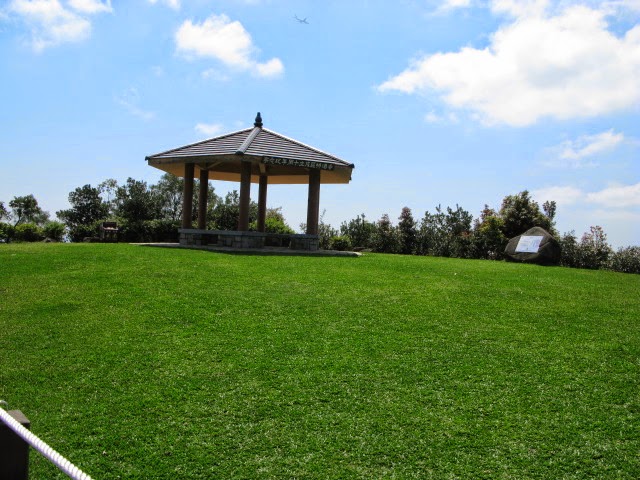 Carpetgrass is a creeping, stoloniferous, perennial warm season grass. It is characterized by flat, two-edged runners or stolons; by wide leaves with blunt, rounded tips and by long, slender seedstalks that terminate with two branches, very similar to crabgrass. Stolons are flat, widely branched and root at each node.
Carpetgrass is a creeping, stoloniferous, perennial warm season grass. It is characterized by flat, two-edged runners or stolons; by wide leaves with blunt, rounded tips and by long, slender seedstalks that terminate with two branches, very similar to crabgrass. Stolons are flat, widely branched and root at each node.
 Leaf sheaths are strongly compressed with fine hairs along the outer margin and densely pubescent around the nodes. The ligule is very short with a fringe of short hairs. The leaf blade is wide, flat, broadly rounded at the base, blunt at the tip and often fringed with hairs.
Leaf sheaths are strongly compressed with fine hairs along the outer margin and densely pubescent around the nodes. The ligule is very short with a fringe of short hairs. The leaf blade is wide, flat, broadly rounded at the base, blunt at the tip and often fringed with hairs.

The seedstalk is tall, slender and often drooping. It branches at the apex into two slender, one-sided spikes, sometimes with a third spike below. Spikelets are oblong, acute, 2 to 25 mm long, pale green or tinged with purple, solitary on alternate sides of the rachis and forming two rows. The lower glume is absent, the upper as long as the spikelet. The anthers are yellowish white or slightly tinged with purple. Seed are yellowish brown and about 1.25 mm long.
Uses
Carpetgrass is best adapted to the middle and lower southern states. It has about the same cold hardiness as centipedegrass and is well adapted to moist, sandy soils. It thrives in areas too wet for bermudagrass and tolerates more shade than bermudagrass.
The ability of carpetgrass to thrive under low fertility makes it suitable for use on low maintenance areas such as parks, roadsides, airports and golf course roughs. Its most objectionable characteristic, frequent and prolonged production of seedstalks, limits its use on lawns. Frequent mowing with a rotary mower is required to maintain a nice looking carpetgrass lawn.
Establishment: Carpetgrass, like all small seeded grasses, requires a loose, smooth and firm seedbed. In heavier soils, disking or rototilling, dragging and rolling may be necessary to develop a good seedbed.
Carpetgrass can be established from seed or sprigs. Seeding is often easier and less expensive. For a quick cover broadcast two pounds of carpetgrass seed per 1,000 sq. ft. of lawn. Rake the lawn lightly after seeding to help cover the seed. A grass drill can also be used effectively for planting carpetgrass seed. For large plantings, where a quick cover is not critical, plant 15 to 20 pounds of carpetgrass seed per acre. Again, a grass drill is the most effective means of seeding carpetgrass.
Seed carpetgrass after the last expected frost in the spring. Mid-April to May are ideal months for seeding carpetgrass. Do not seed after September 15.
Keep the soil moist, but not wet, for about two weeks after seeding. Continue light, frequent watering until the seedlings are rooted and beginning to spread. After the lawn is established, usually 8 to 10 weeks after seeding, water only as needed to prevent severe drought stress.
Carpetgrass does well on acid soils and on soils with a low fertility. However, establishment is hastened by light applications of a complete fertilizer. Apply a complete fertilizer at one pound of nitrogen per 1000 sq. ft. at planting time and at monthly intervals thereafter until the lawn is covered with carpetgrass. Lime is not necessary unless the soil pH is below 5.0
Carpet grass may develop taller leaves under shady conditions, and is best grown in full sun to slightly shady conditions. They require a little more nutrients and water compared to most grasses.
 Kudzu, also called Japanese arrowroot is a group of plants in the genus Pueraria, in the pea family Fabaceae, subfamily Faboideae. They are climbing, coiling, and trailing perennial vines native to much of eastern Asia, southeast Asia, and some Pacific Islands.
Kudzu, also called Japanese arrowroot is a group of plants in the genus Pueraria, in the pea family Fabaceae, subfamily Faboideae. They are climbing, coiling, and trailing perennial vines native to much of eastern Asia, southeast Asia, and some Pacific Islands.
 The name comes from the Japanese name for the plants, kuzu, which was written "kudzu" in historical romanizations. Where these plants are naturalized, they can be invasive and are considered noxious weeds. The plant climbs over trees or shrubs and grows so rapidly that it kills them by heavy shading. Kudzu is an extremely invasive plant in many asian countries, including Hong Kong.
The name comes from the Japanese name for the plants, kuzu, which was written "kudzu" in historical romanizations. Where these plants are naturalized, they can be invasive and are considered noxious weeds. The plant climbs over trees or shrubs and grows so rapidly that it kills them by heavy shading. Kudzu is an extremely invasive plant in many asian countries, including Hong Kong.
Reproduction:Kudzu spreads by vegetative reproduction via stolons (runners) that root at the nodes to form new plants and by rhizomes. Kudzu will also spread by seeds, which are formed in pods and mature in the autumn. Three to five seeds are formed in each pod. The hard-coated seeds may not germinate for several years, which can result in the reappearance of the species years after it was thought eradicated at a site.
Major Uses:
Soil improvement and preservation
Kudzu has been used as a form of erosion control and also to enhance the soil. As a fast growing legume, it increases the nitrogen in the soil via a symbiotic relationship with nitrogen-fixing bacteria.Its deep taproots also transfer valuable minerals from the subsoil to the topsoil, thereby improving the topsoil. In the deforested section of the central Amazon Basin in Brazil, it has been used for improving the soil pore-space in clay latosols, thus freeing even more water for plants than in the soil prior to deforestation.
Animal feed
Kudzu can be used by grazing animals, as it is high in quality as a forage and palatable to livestock. It can be grazed until frost and even slightly after. Kudzu had been used in the southern United States specifically to feed goats on land that had limited resources.
Kudzu hay typically has a 15–18% crude protein content and over 60% total digestible nutrient value. The quality of the leaves decreases, however, as vine content increases relative to the leaf content. Kudzu also has low forage yields despite its rate of growth, yielding around two to four tons of dry matter per acre annually. It is also difficult to bale due to its vining growth and its slowness in shedding water. This makes it necessary to place kudzu hay under sheltered protection after being baled. Kudzu is readily consumed by all types of grazing animals, yet frequent grazing over three to four years can ruin stands. Thus, kudzu only serves well as a grazing crop on a temporary basis.
Invasive species
Ecological damage and roles
Kudzu's environmental and ecological damage results from acting through "interference competition," meaning it out-competes other species for a resource. Kudzu competes with native flora for light, and acts to block their access to this vital resource by growing over them and shading them with their leaves. Plants may then die as a result, from being suffocated.
Control
Crown removal
For successful long-term control of kudzu, it is not necessary to destroy the entire root system, which can be extremely large and deep. It is only necessary to use some method to kill or remove the kudzu root crown and all rooting runners. The root crown is a fibrous knob of tissue that sits on top of the root (rhizome). Crowns form from multiple vine nodes that root to the ground, and range from pea- to basketball-size. The older the crowns, the deeper they tend to be found in the ground, because the root grows deeper with age. Nodes and crowns are the source of all kudzu vines, and roots cannot produce vines. If any portion of a root crown remains after attempted removal, the kudzu plant may grow back.
Mechanical methods of control involve cutting off crowns from roots, usually just below ground level. This immediately kills the plant. Cutting off vines is not sufficient for an immediate kill. It is necessary to destroy all removed crown material. Buried crowns can regenerate into healthy kudzu. Transporting crowns in soil removed from a kudzu infestation is one common way that kudzu "miraculously" spreads and shows up in unexpected locations.
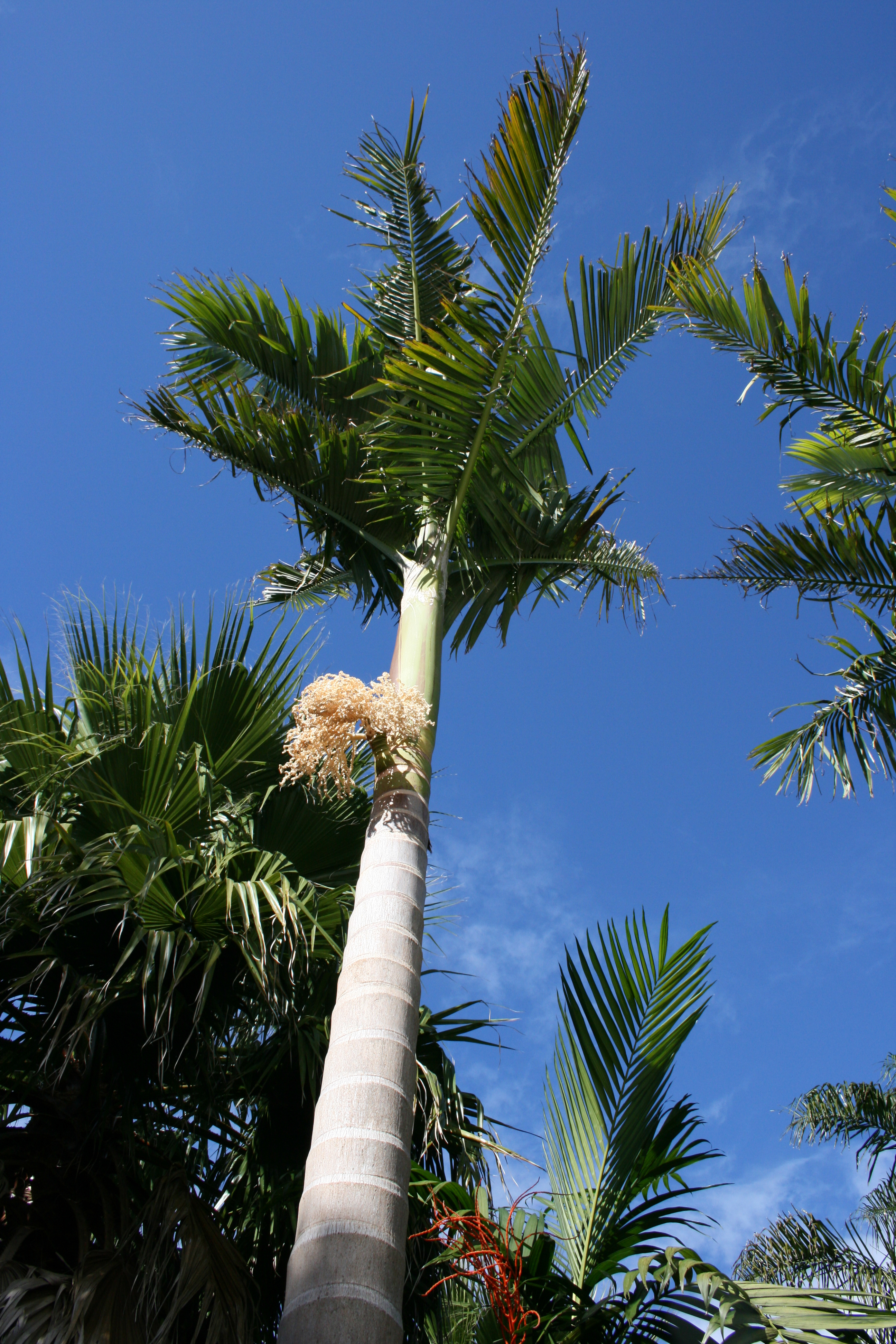 Archontophoenix alexandrae (Alexander palm, Alexandra palm, King Alexander palm, King palm, is a palm native to Queensland, Australia, and naturalised in Hawaii.
Archontophoenix alexandrae (Alexander palm, Alexandra palm, King Alexander palm, King palm, is a palm native to Queensland, Australia, and naturalised in Hawaii.
It grows in littoral rainforest, often in locations that are severely inundated during heavy rain events. Their ability to withstand these conditions allow them to become the dominant species.
The palm makes a great Ornamental plant, and unlike some other kinds of palm trees, Alexander palm does not produce messy fibers, and is a tidy tree.
Alexander palm can only grow in subtropical to tropical countries, with minimum temperatures of 6 degrees Celsius for a few weeks. Grows best in wet and humid subtropical countries.
Adaptable to various kinds of soils.
If you are planning to grow Alexander Palm from seed, start it in a shady area, perhaps under a tree. Otherwise, the seedling's leaves will grow yellow, and the plant will become dormant in growth.
 Monstera deliciosa, the Fruit Salad Plant, is a species of flowering plant native to tropical rainforests of southern Mexico, south to Colombia. It has been introduced to many tropical areas, and has become a mildly invasive species in Hawaii, Seychelles, Ascension Island and the Society Islands. It is also widely grown from ornamental uses in many subtropical countries around the world.
Monstera deliciosa, the Fruit Salad Plant, is a species of flowering plant native to tropical rainforests of southern Mexico, south to Colombia. It has been introduced to many tropical areas, and has become a mildly invasive species in Hawaii, Seychelles, Ascension Island and the Society Islands. It is also widely grown from ornamental uses in many subtropical countries around the world.
 Aerial roots: This species has aerial roots which are there to support the plant growing. These roots which hang from a stem have to be pushed into the compost and they can be placed on a moss stick (plastic tube with netting filled with peat), if you wish the plant to grow very tall.
Aerial roots: This species has aerial roots which are there to support the plant growing. These roots which hang from a stem have to be pushed into the compost and they can be placed on a moss stick (plastic tube with netting filled with peat), if you wish the plant to grow very tall.
How it looks: The monstera deliciosa is primarily grown indoors for the lush green and glossy leaves. Each heart shaped leaf that appears starts of as a full leaf and then begins to form it's slits. These leaves will grow whilst the plant is very young and only a matter of a few inches tall, although they do not produce the slits until it matures more. This species looks similar to a palm tree.
Flowering and fruit: The cheese plant does flower in it's natural habitat or somewhere that mimics it's natural habit very well. It's very rare to see them flower indoors. These flowers are a whitish colored spathe type with a spadix in the center.

The fruit which looks similar to a sweetcorn cone (in shape) are produced after the the flowers have fully bloomed. There is a specific way of knowing these are ready to be eaten, and if they're eaten before they become ripe enough it has been said they can cause mouth irritation. The name deliciosa comes from the fruit being known as tasting delicious. It is also nicknamed the fruit that is a cross between the banana and the pineapple.
Temperature: Temperatures between 65-80 ºF (18-27 ºC) are ideal. Lower than 65ºF (18Cº) will slow down this plants growth and below 50ºF (10ºC) will stop growth.
Light: A fairly bright room or bright with plenty of shade is best. Direct sunlight will damage the leaves and not enough light can slow growth down. Best planted under, or near trees in slightly humid conditions.
If grown in full sun, make sure that the plant receives alot of water and the plant should be a year old. Seedlings tend to yellow in full sun.
Watering: Between watering times allow the soil to become dry to the touch within the top couple of inches or so of soil.
Soil: A peat based potting soil mix with perlite or sand is ideal. However, the plant grows well in many kinds of soil including clay soil which is commonly found in the tropics.
Propagation: Propagate from a mature stem tip cuttings during summer below an aerial root at the node. Place the stem cutting about 1 or 2 inches deep in moist potting soil and water moderately. It should begin rooting within the first couple of weeks or so.
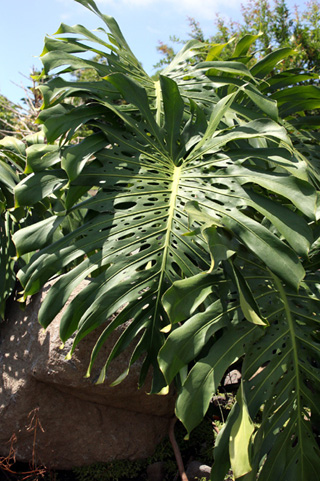 Displaying and growing: These look fantastic in large rooms, hallways, within offices and anywhere else that can cater for their size and caring needs. To grow them tall they will have to be trained, which is fairly easy when using a moss stick. If you don’t have the time or materials to make a moss pole you can purchase them online or in garden stores which is probably a cheaper method. In the wild this plant grows by climbing (climbing shrub) trees (epiphyte) so it gains it's support and moisture from them - which a moss pole is used to imitate.
Displaying and growing: These look fantastic in large rooms, hallways, within offices and anywhere else that can cater for their size and caring needs. To grow them tall they will have to be trained, which is fairly easy when using a moss stick. If you don’t have the time or materials to make a moss pole you can purchase them online or in garden stores which is probably a cheaper method. In the wild this plant grows by climbing (climbing shrub) trees (epiphyte) so it gains it's support and moisture from them - which a moss pole is used to imitate.
Monstera deliciosa is commonly grown for interior decoration in public buildings and as a houseplant. It grows best between the temperatures of 20–30 °C (68–86 °F) and requires high humidity and shade. Growth ceases below 10 °C (50 °F) and it is killed by frost. In the coastal zones of Sicily, especially in the Palermo area, where it is called "zampa di leone" ("lion's paw"), it is often cultivated outdoors. In ideal conditions it flowers about three years after it is planted. Flowering is rare when grown indoors. The plant can be propagated by taking cuttings of a mature plant or by air layering.
Monstera deliciosa and the cultivar 'Variegata' have gained the Royal Horticultural Society's Award of Garden Merit.
Starfruit, also known as carambola, is the fruit of Averrhoa carambola, a species of tree native to the Philippines, Indonesia, Malaysia, India, Bangladesh and Sri Lanka. The fruit is popular throughout Southeast Asia, the South Pacific and parts of East Asia. The tree is also cultivated throughout non-indigenous tropical areas, such as in Latin America, the Caribbean, and the southern United States.
The fruit has distinctive ridges running down its sides (usually five, but can sometimes vary); in cross-section, it resembles a star, hence its name. The entire fruit is edible and is usually eaten out of hand. They may also be used in cooking, and can be made into relishes, preserves, and juice drinks.
This evergreen tree is native to Southeast Asia and the Indian Subcontinent.A. carambolais a small tree or shrub that grows 5–12 metres tall, with rose to red-purple flowers. The flowers are small and bell-shaped, with five petals that have whitish edges. The flowers are often produced year round under tropical conditions.
Averrhoa carambola is an attractive, small, slow-growing evergreen tree with a short-trunk or a shrub. The branches are drooping and the wood is white and turns reddish.
It has a bushy shape with many branches producing a broad, rounded crown. The compound leaves are soft, medium-green, they are spirally arranged around the branches in an alternate fashion. The pinnate leaves have a single terminal leaflet and 5 to 11 nearly opposite leaflets, each leaf is 15–20 cm long, and the 3.8–9 cm long leaflets are ovate or ovate-oblong in shape.
The top sides of the leaves are smooth and the undersides are finely hairy and whitish. The leaflets are reactive to light and tend to fold together at night, they are also sensitive to abrupt shock and when shaken tend to close up also.
The lilac or purple-streaked, downy, flowers are produced in the axils of leaves at the end of twigs. The flowers are arranged in small clusters on the ends of the branches or sometimes on the larger stems and trunk, each cluster is attached to the tree with red stalks. The bell shaped, perfect flowers, are produced in loose panicles that are much-branched with pedicellate flowers; each flower is around 6 mm wide, with 5 petals that have recurved ends. The fruits are showy with an oblong shape: they are longitudinally 5- to 6-angled and 6.35–15 cm long and up to 9 cm wide.
The fruits have a thin, waxy skin that is orange-yellow colored. The juicy fruits are yellow inside when ripe and have a crisp texture and when cut in cross-section are star shaped. The fruits have an oxalic acid odor, which varies between plants from strong to mild, the taste also varies from very sour to mildly sweetish. Each fruit may have up to twelve 6-12.5 mm long seeds, which are flat, thin and brown. Some cultivated forms produce fruits with no seeds.

 Rhodomyrtus tomentosa also known as Rose Myrtle is a flowering shrub in the family Myrtaceae, native to southern and southeastern Asia, from India, east to southern China, Hong Kong, Taiwan and the Philippines, and south to Malaysia and Sulawesi. It grows in grasslands, shrublands, forest edges, besides streams, from sea level up to 2400 m elevation.
Rhodomyrtus tomentosa also known as Rose Myrtle is a flowering shrub in the family Myrtaceae, native to southern and southeastern Asia, from India, east to southern China, Hong Kong, Taiwan and the Philippines, and south to Malaysia and Sulawesi. It grows in grasslands, shrublands, forest edges, besides streams, from sea level up to 2400 m elevation.
Description:
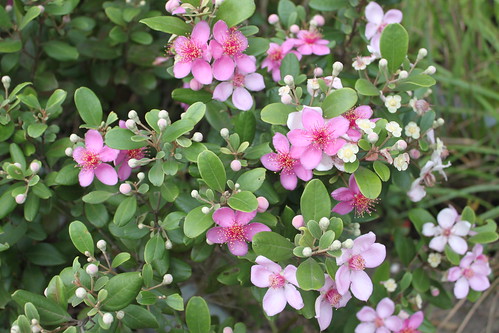 Rhodomyrtus tomentosa is an evergreen shrub growing up to 4 m-12 feet tall. The leaves are opposite, leathery, 5–7 cm long and 2-3.5 cm broad, three-veined from the base, oval, obtuse to sharp pointed at the tip, glossy green above, densely grey or rarely yellowish-hairy beneath, with a wide petiole and an entire margin. The flowers are solitary or in clusters of two or three, 2.5–3 cm diameter, with five petals which are tinged white outside with purplish-pink or all pink.
The fruit is edible, 10–15 mm long, purple, round, three or four-celled, capped with persistent calyx lobes, soft, with 40-45 seeds in a double row in each cell; seed dispersal is by frugivorous birds and mammals. Seed production and germination rates are high.
Rhodomyrtus tomentosa is an evergreen shrub growing up to 4 m-12 feet tall. The leaves are opposite, leathery, 5–7 cm long and 2-3.5 cm broad, three-veined from the base, oval, obtuse to sharp pointed at the tip, glossy green above, densely grey or rarely yellowish-hairy beneath, with a wide petiole and an entire margin. The flowers are solitary or in clusters of two or three, 2.5–3 cm diameter, with five petals which are tinged white outside with purplish-pink or all pink.
The fruit is edible, 10–15 mm long, purple, round, three or four-celled, capped with persistent calyx lobes, soft, with 40-45 seeds in a double row in each cell; seed dispersal is by frugivorous birds and mammals. Seed production and germination rates are high.

